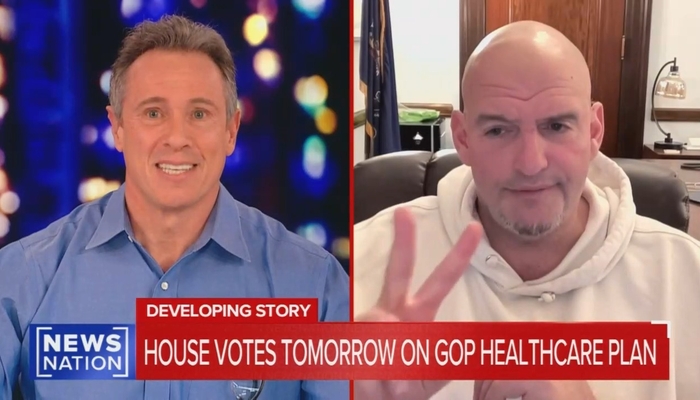
www.newsbusters.org
Senator Fetterman Goes on Cuomo, DESTROYS the Fake War Crimes Hoax
For the past few weeks and as part of the “Don’t Give Up the Ship” operation, we’ve been told that the United States military has been blowing up random drug boats in the southern Caribbean, particularly close to Venezuela. Today, for the first time, we hear a Democrat discuss Operation Southern Spear with a perspective that goes beyond party orthodoxy.
Watch as noted Sheetz enthusiast Sen. John Fetterman (D-PA) goes on Chris Cuomo’s eponymous NewsNation show and completely destroys that narrative:
WATCH: Sen. John Fetterman went on Cuomo and destroyed the War Crimes Hoax in less than a minute.
CHRIS CUOMO: Topic switch. What did you learn, Senator, that gave you any comfort that we're not heading into some kind of extended military exercise around Venezuela or in… pic.twitter.com/3zuBMOY5bQ
— Jorge Bonilla (@BonillaJL) December 17, 2025
CHRIS CUOMO: Topic switch. What did you learn, Senator, that gave you any comfort that we're not heading into some kind of extended military exercise around Venezuela or in Venezuela?
JOHN FETTERMAN: Absolutely. I- I thought- I thought it was pretty- comprehensive and of this. This idea- some things out in the media. It's kind of putting out this- the military's just picking off, you know, anybody that comes across, that's just not true. I mean, there's extensive intelligence and they know exactly who's on that boat and they know what's actually on that boat right now. And it’s quite frequently they- they decline to take it in to move on those things. When they move on those kinetic kinds of strikes, you know, they have absolute confidence that who's on it and what's on it. And that's exactly what it's about. They're not just going around randomly to shooting- shooting boats and those things. That's just not the fact. At all.
We were sold a bill of indiscriminate strikes against random targets, and potential war crimes. We were told that the destruction of these narcovessels were the illegal orders to which Slotkin, Kelly et. al kept constantly circling back to without evidence.
Of course, this narrative debunking didn’t happen on ABC, CBS, NBC, CNN or MS NOW. It happened on NewsNation, and on former ABC and CNN journalist’s eponymous show Cuomo.
Just to drive the point home, Fetterman doubled down on what the operation is and is not:
FETTERMAN: And it doesn't matter. If there's a boat there, they're going to take it out out there. They're actually, you know, very, very careful to make sure they're hitting the right people that have the right kinds of cargoes.
A Democrat Senator debunking the left’s favorite talking points on Venezuela should be news. Cuomo, to his credit, allowed Fetterman to speak about what he saw and heard at the classified briefing, as opposed to just forcing a set of talking points upon his guest.
So much of our media are devoted to narrative and anti-news. But not anymore.
Watch the full transcript of the aforementioned segment as aired on Newsnation’s CUOMO on Tuesday, December 16th, 2025:
CHRIS CUOMO: Topic switch. What did you learn, Senator, that gave you any comfort that we're not heading into some kind of extended military exercise around Venezuela or in Venezuela?
JOHN FETTERMAN: Absolutely. I- I thought- I thought it was pretty- comprehensive and of this. This idea- some things out in the media. It's kind of putting out this- the military's just picking off, you know, anybody that comes across, that's just not true. I mean, there's extensive intelligence and they know exactly who's on that boat and they know what's actually on that boat right now. And it’s quite frequently they- they decline to take it in to move on those things. When they move on those kinetic kinds of strikes, you know, they have absolute confidence that who's on it and what's on it. And that's exactly what it's about. They're not just going around randomly to shooting- shooting boats and those things. That's just not the fact. At all.
CUOMO: So we heard from the president today. He kind of expanded the circle here and said it's not just about drugs. It's about oil. And they are a terr- the whole regime. The whole country is a foreign terror organization,” a total and complete blockade of all sanctioned oil tankers going in and out until they return what they stole from us.” What did they steal and what do you make of this?
FETTERMAN: Yeah, well it makes it that Iran is involved on that. And Russia is involved in that. And China as well too. I mean, a lot of these things, I mean, that's sanctioned oil right now. And those are the kinds of funds that support regions like in Iran is as well too. And absolutely, right now it's not a plan to like a land war and invade Venezuela and that, but seizing those kinds of oil tankers, and it's undeniable that that's oil that's going to support Iran. And those are kinds of funds that are used, all kinds of illicit things with terrorism. So- so for me, it makes a lot of sense based upon what I've seen.
CUOMO: Senator, why were you not willing to go along with Senator Rand Paul, Republican, obviously- and other Democrats with his War Powers resolution to require the president to come and make a show to the Congress before continuing with unilateral military plans and actions?
FETTERMAN: I think it's- I think what's happening right now is consistent and I think that to me it's not unreasonable to compare that to what would president Obama's been doing during his presidency, and he was using drone hits and he took out thousands of people and terrorists. And, of course, if I was in the Senate that time, I would have supported those as well too. You know, that's the President and you have some kind of discretion and kinds of things. Now, I don't think anyone in the Senate would support like a full on land- land invasion or putting American boots on in Venezuela. But currently right now, that's not what's happening. And there is extensive cooperation with nations in the region. And these are not just random strikes. They know exactly that it's in and that's not- and again, it's been very clear that they decline on, often, kinds of boats when they can't be absolutely sure exactly what's on it and who's on it, including no women and children or anything.
CUOMO: I get you with what you’ve seen that you have more comfort that they’re- they’re following the evidence. Right now, of course, their problem is they haven't been making any show of evidence until very recently with this meeting and a couple of others. The difference, you know, with President Obama and my personal opinions about how that war was prosecuted aside, he did have the 2001-2002 authorizations for use of military force. There is no such thing hee that gives power to the president to do what he's doing.
FETTERMAN: Again, well, what I'm saying is what I, at least for me, what I've heard there are these are very specific targeted and targeted boats and they know exactly who's on it, what’s in it there as well, too. And this also involves the oil tankers. Now that's oil. And that's- that's supporting Iranian regime.
CUOMO: Listen, I get it and I wouldn't want to be in the debate on the side of “I want to protect the drug dealers” or “I want to protect Iran and oil”. But it is essentially sending a message that the President of the United States says you get a death sentence if you are trafficking in drugs. And that's certainly not the sentence and punishment. If you are convicted domestically, but isn't that what we're saying here that, hey, we think you are trafficking in drugs- we’re going to kill you. You okay with that?
FETTERMAN: Yeah, I mean, and right now I think if you do- if you would describe when, you know, 75,000 Americans are dying of overdoses, and they really absolutely know that what's on those boats and is on those boats as well, too. And those- are those are organizations and gangs designed as essentially terrorist organizations for that. Now, I know it's it's different kinds of definitions here. But for right now, you know, I you know, I emerged from that now and I feel comfortable where they are not just blowing up random boats.
CUOMO: Gotcha.
FETTERMAN: And it doesn't matter. If there's a boat there, they're going to take it out out there. They're actually, you know, very, very careful to make sure they're hitting the right people that have the right kinds of cargoes.
CUOMO: Senator Fetterman, I appreciate your candor. I appreciate you taking the opportunity as always. If I don't get to speak to you before, I’ll reach out. But I wish you the best for the holy days, for Christmas, for the New Year's. And thank you for being on the show at NewsNation.
FETTERMAN: Chris, thank you for having me. I'm always have me back.
CUOMO: I hope you get it done and I hope you get some relief for these 20-24 million people who need these subsidies. It’s good to know you’re fighting for that.
FETTERMAN: I sure hope so.
CUOMO: All right. Thank you, Sir.
FETTERMAN: Thank you too, we could all be- we could all be Santa Claus, but no- for me, it’s like “I’m here to vote for that. I'm here. I sure hope so. But thank you. Thank you for having me on.
COUMO: Santa Claus would be great. Just not being The Grinch would be good enough. Take care, Senator. Thank you very much.
FETTERMAN: All right. Thank you.
















